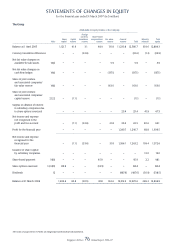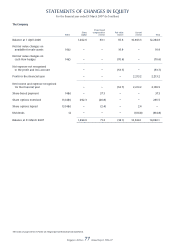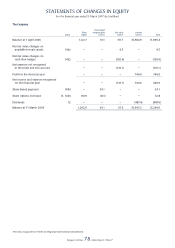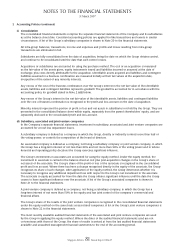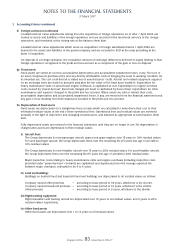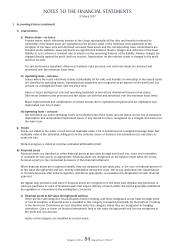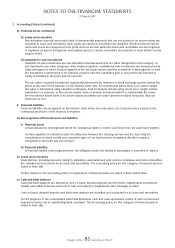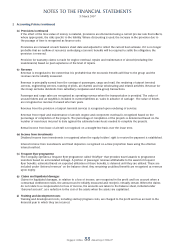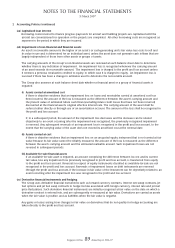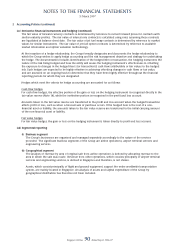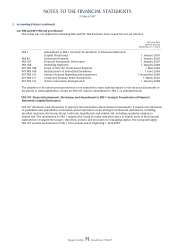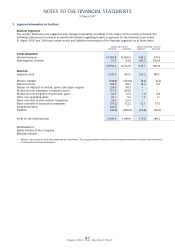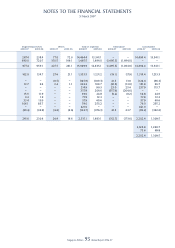Singapore Airlines 2007 Annual Report Download - page 87
Download and view the complete annual report
Please find page 87 of the 2007 Singapore Airlines annual report below. You can navigate through the pages in the report by either clicking on the pages listed below, or by using the keyword search tool below to find specific information within the annual report.Singapore Airlines 85 Annual Report 2006-07
NOTES TO THE FINANCIAL STATEMENTS
31 March 2007
2 Accounting Policies (continued)
(k) Financial assets (continued)
(ii) Loans and receivables
Non-derivative fi nancial assets with fi xed or determinable payments that are not quoted in an active market are
classifi ed as loans and receivables. Such assets are carried at amortised cost using the effective interest method.
Gains and losses are recognised in the profi t and loss account when the loans and receivables are derecognised
or impaired, as well as through the amortisation process. Current receivables are included in trade debtors on the
balance sheet.
(iii) Available-for-sale investments
Available-for-sale investments are non-derivative fi nancial assets that are either designated in this category, or
not classifi ed in any other categories. After initial recognition, available-for-sale investments are measured at fair
value with gains or losses being recognised in the fair value reserve until the investment is derecognised or until
the investment is determined to be impaired at which time the cumulative gain or loss previously reported in
equity is included in the profi t and loss account.
The fair value of quoted investments is generally determined by reference to stock exchange quoted market bid
prices at the close of the business on the balance sheet date. For investments where there is no active market,
fair value is determined using valuation techniques. Such techniques include using recent arm’s length market
transactions or reference to the current market value of another instrument (which is substantially the same).
For investments where there is no active market and where fair value cannot be reliably measured, they are
measured at cost.
(l) Financial liabilities
Financial liabilities are recognised on the balance sheet when, and only when, the Group becomes a party to the
contractual provisions of the fi nancial instrument.
(m) Derecognition of fi nancial assets and liabilities
(i) Financial assets
A fi nancial asset is derecognised where the contractual rights to receive cash fl ows from the asset have expired.
On derecognition of a fi nancial asset, the difference between the carrying amount and the sum of (a) the
consideration received and (b) any cumulative gain or loss that has been recognised directly in equity is
recognised in the profi t and loss account.
(ii) Financial liabilities
A fi nancial liability is derecognised when the obligation under the liability is discharged or cancelled or expires.
(n) Loans and receivables
Trade debtors, including amounts owing by subsidiary, associated and joint venture companies and other receivables,
are classifi ed and accounted for as loans and receivables. The accounting policy for this category of fi nancial assets is
stated in Note 2(k).
Further details on the accounting policy for impairment of fi nancial assets are stated in Note 2(ab) below.
(o) Cash and bank balances
Cash and bank balances are defi ned as cash on hand, demand deposits and short-term, highly liquid investments
readily convertible to known amounts of cash and subject to insignifi cant risk of changes in value.
Cash on hand, demand deposits and short-term deposits are classifi ed and accounted for as loans and receivables.
For the purposes of the Consolidated Cash Flow Statement, cash and cash equivalents consist of cash on hand and
deposits in banks, net of outstanding bank overdrafts. The accounting policy for this category of fi nancial assets is
stated in Note 2(k).



